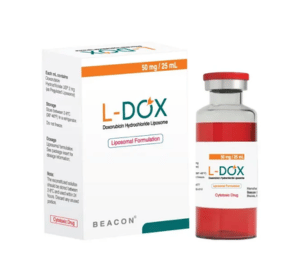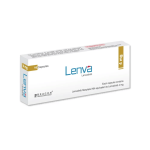L-DOX

Generic Name:Doxorubicin Hydrochloride Liposome
Indications
L-DOX injection is indicated for the treatment of:
Ovarian Cancer: L-DOX injection is indicated for the treatment of patients with ovarian cancer whose disease has progressed or recurred after platinum-based chemotherapy.
AIDS-Related Kaposi’s Sarcoma: It is indicated for the treatment of AIDS-related Kaposi’s sarcoma in patients with disease that has progressed on prior combination chemotherapy or in patients who are intolerant to such therapy.
Multiple Myeloma: For the treatment of patients with multiple myeloma in combination with Bortezomib, who have not previously received Bortezomib and have received at least one prior therapy.
Also indicated for the monotherapy for patients with metastatic breast cancer, where patient is associated with increased cardiac risk with conventional L-DOX.
Composition
20 mg Injection: Each 10 ml contains Doxorubicin Hydrochloride USP 20 mg (as pegylated Liposome).
50 mg Injection: Each 25 ml contains Doxorubicin Hydrochloride USP 50 mg (as pegylated Liposome).
Pharmacology
Doxorubicin is a cytotoxic anthracycline antibiotic isolated from Streptomyces Peucetius var. Caesius. Doxorubicin Hydrochloride Liposome injection is Doxorubicin Hydrochloride encapsulated in Stealth Liposomes for intravenous administration. Greater than 90 % of the drug is encapsulated in the stealth Liposomes.
The active ingredient of Doxorubicin Hydrochloride Liposome Injection is Doxorubicin Hydrochloride. The mechanism of action of Doxorubicin Hydrochloride is thought to be related to its ability to bind DNA and inhibit nucleic acid synthesis. Cell structure studies have demonstrated rapid cell penetration and perinuclear chromatin binding, rapid inhibition of mitotic activity and nucleic acid synthesis, and induction of mutagenesis and chromosomal aberrations.
Doxorubicin Hydrochloride Liposome injection displays linear pharmacokinetics over the range of 10-20 mg/m2 . Disposition occurs in two phases after administration of Doxorubicin Hydrochloride Liposome injection, with a relatively short first phase (5 hours) and a prolonged second phase (55 hours) which accounts for majority of the area under the curve (AUC).
Distribution: Direct measurement of Doxorubicin Hydrochloride Liposome injection shows that at least 90% of the drug (the assay used cannot quantify less than 5-10% free doxorubicin) remains Liposome-encapsulated during circulation.
Metabolism: Doxorubicinol, the major metabolite of Doxorubicin, was detected at concentrations of 0.8 to 26.2 ng/mL in the plasma of patients who received 10 or 20 mg/m 2 Doxorubicin Hydrochloride Liposome injection
Excretion: The plasma clearance of total Doxorubicin Hydrochloride Liposome injection was 0.041 L/h/m2 at a dose of 20 mg/m2 . Following administration of Doxorubicin Hydrochloride, the plasma clearance of doxorubicin is 24 to 35 L/h/m2 .
Dosage
Ovarian Cancer Patients: The recommended dose is 50 mg/m2 intravenously over 60 minutes every 28 days until disease progression or unacceptable toxicity.
AIDS-Related Kaposi’s Sarcoma: The recommended dose is 20 mg/m2 intravenously over 60 minutes every 21 days until disease progression or unacceptable toxicity.
Multiple Myeloma: The recommended dose is 30 mg/m2 intravenously over 60 minutes on day 4 of each 21-day cycle for eight cycles or until disease progression or unacceptable toxicity. Administer it after Bortezomib on day 4 of each cycle.
Dose Modification: Guidelines have been proposed since Doxorubicin Hydrochloride Liposome injection
exhibits nonlinear pharmacokinetics at 50 mg/m2. Dose adjustments may thus result in non-proportional greater change in plasma concentration and exposure to the drug. Patients should be carefully monitored for toxicity. Adverse events such as Palmar Plantar Erythema (PPE), hematologic toxicities, and stomatitis may be managed by dose delays and adjustments. Subsequent to the first appearance of a Grade 2 or higher adverse event, dosing should be adjusted and or delayed as described in the following tables and should not be increased at any given time.
Pediatric Use: The safety and effectiveness of Doxorubicin Hydrochloride Liposome injection in pediatric patients have not been established.



